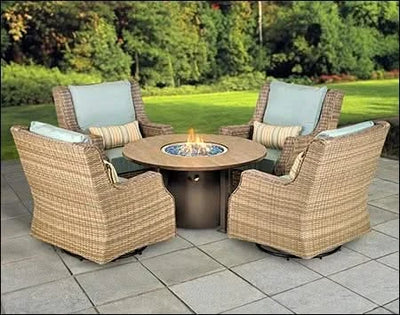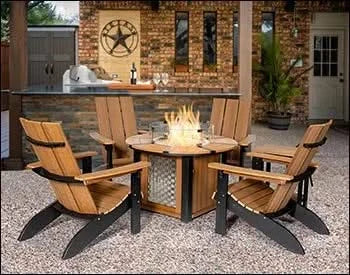Like all things in life, mastering the art of something takes practice and patience. The art of firewood stacking for your wood burning fire pit is no different.
A well-stacked wood burning fire pit can transform a chilly evening into a cozy gathering. It's a skill that, once mastered, can elevate your outdoor experiences. In this guide, we'll delve into the intricacies of firewood stacking, from choosing the right wood to employing effective techniques.
Whether you're a seasoned camper or a backyard fire pit enthusiast, you'll find valuable tips to enhance your fire-building prowess. Let's ignite your knowledge and set the stage for unforgettable fireside moments.
Table of Contents
How to Best Prepare Your Wood Burning Fire Pit for Firewood
Before you dive into the exciting world of firewood stacking, ensure your fire pit is ready. Here's how:
- Clean Up: Remove any debris, ashes, or leftover wood from your previous fire. A clean fire pit ensures optimal airflow and a safer burning experience.
 Cleaning ash and debris from wood burning fire pit
Cleaning ash and debris from wood burning fire pit- Safety First: Always prioritize safety. Choose a level surface away from flammable structures. Keep a fire extinguisher or a bucket of water nearby.
Why Wait to Stack Firewood?
Stacking firewood before preparing your fire pit can lead to several issues:
- Soiling the wood burning fire pit: Wood can introduce dirt, debris, or pests, making it less clean and efficient.
- Hindering fire starting: Pre-stacked wood can obstruct airflow, making it harder to light the fire.
- Damaging the wood: Moisture and exposure to the elements can degrade the quality of the wood.
To ensure a successful fire, wait until your fire pit is ready to start stacking your firewood.
Choosing the Perfect Firewood
The type of wood you choose significantly impacts the quality of your fire. Here are some tips:
- Hardwoods: Opt for hardwoods like oak, maple, or hickory. They burn hotter and longer, producing less smoke.
 Best hardwood types for wood burning fire pits
Best hardwood types for wood burning fire pitsWhile hardwoods are excellent for home fire pits, they might not be the best choice for every scenario. For example, if you're camping and need to start a fire quickly, softwoods like pine or cedar can be easier to ignite. However, they burn faster and produce more smoke.
- Seasoned Wood: Ensure your wood is well seasoned. Seasoned wood has a lower moisture content, burns more efficiently, and produces less smoke.
While seasoned hardwood is a great choice for home use, it might not be the most practical option for camping. In a camping scenario, softer, less seasoned woods might be easier to ignite, especially in damp conditions. However, they may produce more smoke and burn less efficiently.
Shop Fire Pit Logs Stacking Techniques: A Fire Starter's Guide
Now comes the fun part: stacking your firewood on a wood burning fire pit. Here are some popular techniques:
Teepee
Ideal for quick, intense heat. Perfect for roasting marshmallows or heating up quickly.
 Quick and Easy: The teepee method is perfect for a fast fire.
Quick and Easy: The teepee method is perfect for a fast fire.Log Cabin
Best for longer-burning fires, ideal for cozy evenings or overnight camping trips.

Lean-To
This fire log laying technique is when logs lean against a larger log to create a windbreak. Highly effective in windy conditions, as it creates a windbreak to protect the fire.
 The lean-to technique is perfect for windy conditions
The lean-to technique is perfect for windy conditionsUpside-Down Fire
A unique method that provides consistent heat with huge flames and requires minimal maintenance.

Swedish Torch
A dramatic and long-lasting option, perfect for outdoor gatherings or cooking.
Choosing the Right Fire Wood Stacking Technique based on your Environment
The best technique for you will depend on your specific needs and the environment. Here's a quick breakdown:
Home Wood Burning Fire Pits
Log Cabin or Upside-Down Fire for consistent, long-lasting heat.
Camping Fire Pits
Teepee for quick ignition or Lean-To for windy conditions.
Additional Tips:
- Always use seasoned wood as it is ideal for any fire pit, whether at home or while camping. It burns more efficiently, producing less smoke, and providing a longer-lasting fire.
- Start with kindling because it is essential for starting a fire. Small twigs and branches can easily ignite and help larger logs catch fire.
- Add larger logs gradually. Gradually adding larger logs allows the fire to build steadily and maintain a consistent heat output. Avoid overloading the fire with too many large logs at once, as this can suffocate the flames.
- Monitor your fire.
- Never leave a fire unattended.
By following these tips and experimenting with different stacking techniques, you can create the perfect fire for any occasion.
Airflow and Fire Maintenance
A well-ventilated fire burns hotter and more efficiently. Here's how to ensure your fire gets the oxygen it needs:
- Airflow: Leave gaps between logs to allow for proper airflow. This ensures a hotter, more efficient burn.
- Avoid Overpacking: Don't overcrowd your fire pit. This can suffocate the flames and hinder the burning process.
- Maintaining the Fire: Keep an eye on your fire and add more wood as needed. Use a poker to adjust the logs and maintain airflow.
Fire Safety and Cleanup
Safety should always be a top priority when enjoying a fire. Here are some essential tips to ensure a safe and responsible fire:
- Extinguishing the Fire: Always fully extinguish your fire before leaving. Douse it with water, stir the ashes, and ensure all embers are out.
- Cleaning Up: Remove any remaining ashes and debris from your fire pit.
- Fire Pit Maintenance: Regularly clean your fire pit to prevent buildup and ensure optimal performance.
FAQs: How to Stack Firewood in a Fire Pit
Q: How high should I stack firewood in my fire pit?
A: Stack your firewood to about two-thirds of the fire pit's height. This allows for proper airflow and prevents the fire from spreading too quickly.
Q: Can I use green wood in my fire pit?
A: It's best to avoid green wood as it burns poorly and produces excessive smoke. Opt for seasoned wood for a cleaner and more efficient burn.
Q: How long does firewood need to season?
A: Firewood typically needs to season for 6-12 months. Seasoned wood has a lower moisture content and burns more efficiently.
Q: What's the best way to start a fire in wet conditions?
A: Use dry kindling and tinder to start your fire. You can also use a fire starter or dryer lint to help ignite the wood.
About Lux Yard and Homes
Lux Yard and Homes is your go-to source for all things home and garden. We provide expert advice, product recommendations, and design inspiration to help you create your dream outdoor space.
Whether you're a seasoned fire pit enthusiast or a beginner, we hope these tips help you master the art of firewood stacking. Happy fires!







